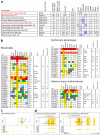Mapping and analysis of chromatin state dynamics in nine human cell types
- PMID: 21441907
- PMCID: PMC3088773
- DOI: 10.1038/nature09906
Mapping and analysis of chromatin state dynamics in nine human cell types
Abstract
Chromatin profiling has emerged as a powerful means of genome annotation and detection of regulatory activity. The approach is especially well suited to the characterization of non-coding portions of the genome, which critically contribute to cellular phenotypes yet remain largely uncharted. Here we map nine chromatin marks across nine cell types to systematically characterize regulatory elements, their cell-type specificities and their functional interactions. Focusing on cell-type-specific patterns of promoters and enhancers, we define multicell activity profiles for chromatin state, gene expression, regulatory motif enrichment and regulator expression. We use correlations between these profiles to link enhancers to putative target genes, and predict the cell-type-specific activators and repressors that modulate them. The resulting annotations and regulatory predictions have implications for the interpretation of genome-wide association studies. Top-scoring disease single nucleotide polymorphisms are frequently positioned within enhancer elements specifically active in relevant cell types, and in some cases affect a motif instance for a predicted regulator, thus suggesting a mechanism for the association. Our study presents a general framework for deciphering cis-regulatory connections and their roles in disease.
©2011 Macmillan Publishers Limited. All rights reserved
Figures





Comment in
-
Highlighting enhancers.Nat Methods. 2011 May;8(5):373. doi: 10.1038/nmeth0511-373. Nat Methods. 2011. PMID: 21678620 No abstract available.
References
-
- Ludwig TE, et al. Feeder-independent culture of human embryonic stem cells. Nat Methods. 2006;3:637–646. - PubMed
-
- Geiss GK, et al. Direct multiplexed measurement of gene expression with color-coded probe pairs. Nat Biotechnol. 2008;26:317–325. - PubMed
-
- Reich M, et al. GenePattern 2.0. Nat Genet. 2006;38:500–501. - PubMed
Publication types
MeSH terms
Substances
Associated data
- Actions
Grants and funding
LinkOut - more resources
Full Text Sources
Other Literature Sources
Molecular Biology Databases

